This entry was posted on
Thursday, January 26th, 2012 at
8:58 am and is filed
under Old Media, Rupert ‘The Evil One’ Murdoch.
“Sometimes, Robin, being certain is merely being wrong at the top of your voice.” – Batman
It was almost 6 months ago that I first wrote about my concerns about the behaviour of News of the World in the weeks after the disappearance of Milly Dowler. At the time, I also expressed some concern about the subsequent response to News of the World by Surrey Police. Since then, more information has come to light. It is not comforting on either front.
With the publication of this letter especially, it is now clear that police were misrepresented to a great degree in the 14 April 2002 article analysed in this post, not least because the News of the World all-too-readily gave the appearance of speaking on behalf of police, both in print and during their pursuit of tabloid fodder (even to the extent of claiming to be working in conjunction with the police when interrogating members of the public).
This does not put Surrey Police in the clear. Far from it.
1.
As far back as 13 April 2002, Surrey Police were aware that News of the World had accessed Milly Dowler’s voice messages. Police report in this letter that they were told quite bluntly by one of the reporters involved that “NOTW had got Milly’s phone number and PIN from school children”. To this date there is no indication that any kind of investigation took place. Surrey Police, in their 17 Jan 2012 letter, skip from mentioning the extensive investigation into Milly Dowler’s disappearance to saying; “Surrey Police did not arrest or charge anyone in relation to accessing Milly Dowler’s voicemail”
I will return to this point toward the end of this post.
(Oh, and you will probably want to keep this same point in mind for a later post that I dare not even hint at right now. If you’re a long-time reader, you will totally plotz.)
2.
This recently-released letter details correspondence where the police suspected the involvement of a hoaxer in a recruitment company’s phone call to Milly Dowler’s mobile phone more than a week after she had gone missing. By all indications, police couched their phrases accordingly. For example, in a core statement, Surrey Police said there was “the possibility that a hoaxer might have been involved.”
Now watch that suspicion portrayed as rock-solid belief in the resulting article (14 April 2002):
3.
Within a week, Surrey Police had determined that the hoaxer plaguing their investigation was not involved in any approach to the relevant recruitment agency as described by News of the World. Neither was the mysterious phone message anything to do with Milly Dowler herself, or anyone who knew her; it was just an unfortunate coincidence. But News of the World would not listen. By this stage (20 April), they were “110% certain” that 13-year-old Milly Dowler had run away from home and was out looking for work on the other side of the country:
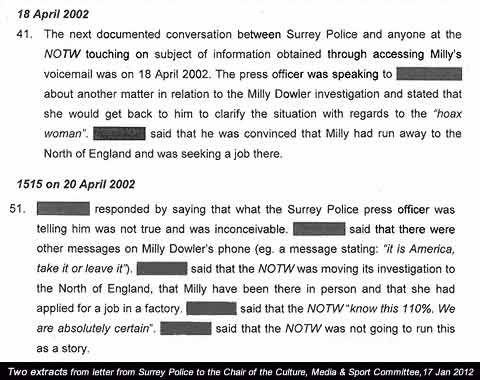
A day later (21 April 2002), News of the World published extracts from the personal diary of a 13-year-old friend of Milly Dowler (who should NOT be assumed to be the source of any phone details, and should NOT carry any guilt/blame for trusting these tabloid scumbags in any instance). Note how News of the World give the impression that they are revealing this intimate detail at the behest of police detectives. The opening paragraphs even risk giving the impression that access to this diary was offered/granted to News of the World by those same unnamed police detectives.
Also note that they spare a final inch to have an oh-so-subtle shot at Surrey Police. Keep in mind here that News of the World were at this stage “110% certain” that the police were looking in the wrong place for Milly Dowler, who they believed to be looking for work up north… when she had by this stage been dead for near to a month:
Let’s add to this that the line of questioning they aimed at a 13-year-old girl is bloody obvious. This vulnerable child is saying her friend would not run away because some sod from a tabloid has been asking if she’s really, really sure about that. The scope and cost of the arrogance of News of the World is breathtaking.
On that note, here’s the editorial from that issue (21 April 2002). The editor makes a point of mentioning the possibility that Milly Dowler simply ran away. Based on what?
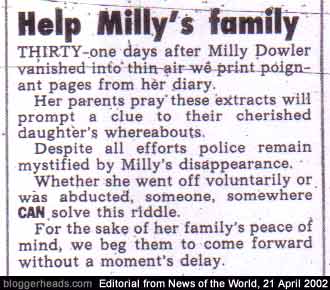
It is also worth mentioning that News of the World suffer here from that peculiar tabloid ailment of being quite unable to admit error or fault. There is no mention on 21 April 2002 of their being entirely wrong about the recruitment agency story a week earlier.
4.
In fact, a week later (28 April 2002), they use the arrest of the hoaxer to give the impression that they were right about the recruitment agency/call article all along. The mention of phone calls in this passage adds to this illusion. I can assure you that in my experience this is quite common, and usually quite deliberate. I even know tabloid-style bloggers who behave in this way. I don’t like them very much:
Also note that once again the oh-so-superior News of the World have taken the time to have a shot at Surrey Police, portraying them as slow to respond if not incompetent. In their view, detectives were wasting their time on kidnap/homicide-oriented nonsense. News of the World were “110% certain” that 13-year-old Milly Dowler was alive and well and seeking work.
5.
Where Surrey Police do deserve criticism is in their inexplicable willingness to be repeatedly treated as Rebekah Wade’s bitch.
And finally…
6.
I would very much like to hear a response from Sussex Police. I’d like to know more about the “routine review” of the Milly Dowler investigation described here and what it entailed. I would particularly like to know why Sussex Police failed to call Surrey Police to account for failing to call News of the World to account. I’m only a layman, but I rather got the impression that such reviews were meant to be some form of quality control beyond the influence of locals and any associated bias.
–
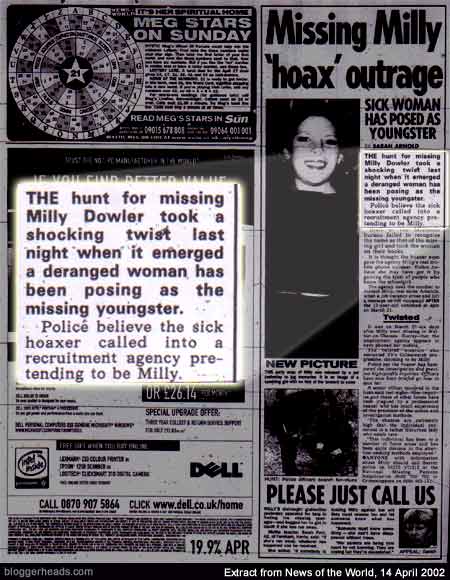
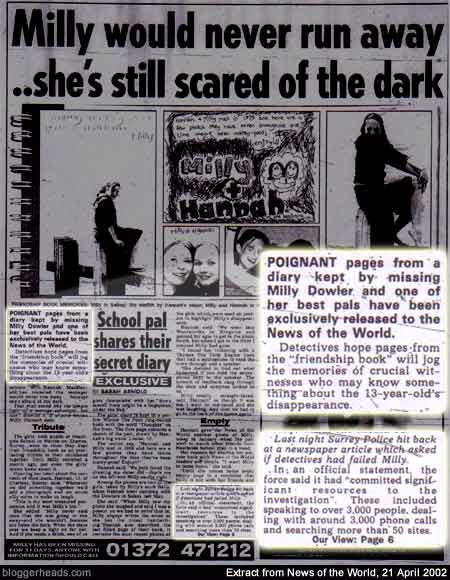
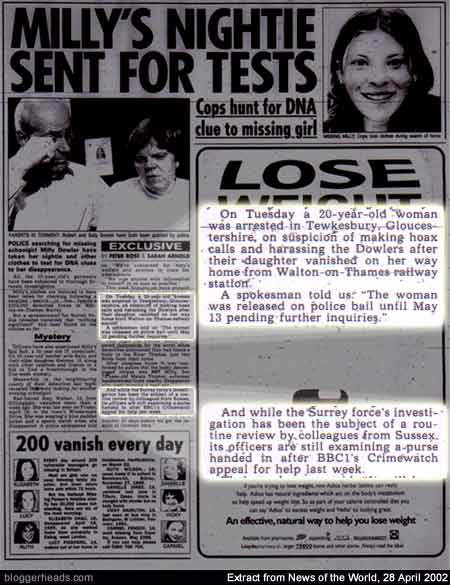


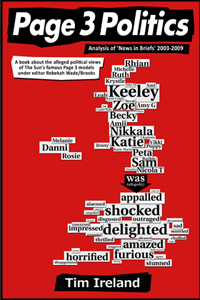

By rob January 26, 2012 - 9:37 am
Any idea as to which police forces in the UK were not able to respond adequately to the power wielded by News International and which could therefore perform efficient independent reviews of other forces? I am sure that there are very good policemen doing a very good job in most of these forces but are they the ones at the top?
By Neuroskeptic January 26, 2012 - 9:46 am
You think THIS is bad? The Guardian wrote an article that was only 99% true, and it resulted in this fine paper being closed down, in a surge of knee-jerk reaction of the kind that the NoTW would never in a lifetime have tried to whip up about anything.
The fact is that many fine journalists lost their jobs when the NoTW closed down. Well, OK, many journalists. Well, OK, many people. But the point is, they lost their job, just because the Guardian revealed the truth, and that is the most shocking thing of all. For shame.
By rob January 26, 2012 - 10:31 am
Yes, some people lost their jobs because those at the top wanted to put the matter "in a box" . That is a capitalist's right to do with their company as they wish; many people have lost their jobs as a result of a few unregulated bankers. But how does a similar problem in a public service i.e. a police force get resolved when those at the top at are all involved and democracy is all tied up with vested interests?
By Guano January 27, 2012 - 10:17 am
This is the crux of the matter. Journalists getting in the way of a police investigation and ……… nothing happens. If NOTW behaved in this way it is probably because experience told them that they could do so without any any risk, which suggests that this had happened before and …… nothing happened. So what was the deal? Or are powerful organistaions like NI now simply considered as being beyondthe reach of the law?
By mediawatch February 8, 2012 - 1:32 am
what about the reporter Tom Vanden Brook for USA Today who gained national notoriety when he inaccurately reported and was at fault for publishing in USA Today a Headline story that the The Sago Mine disaster victims were found alive, when in fact the 12 miners were not alive and only one miner survived.
Tom Vanden Brook's USA Today headline story read, “‘Alive!’ Miners Beat the Odds,” over a photo of two smiling women with pictures of relatives of miners they believed had been found alive after reading Tom Vanden Brook's headline news story. The stark evidence of a rush to get a story without verifying the most important aspect of the story, and with tragic and heart-wrenching results created a major controversy. USA Today was up against a deadline, but it was still an inexcusable error.
The disaster received extensive news coverage worldwide. After Tom Vanden Brook released the incorrect information, many media outlets, including the New York Times, then reported that 12 survivors had been found alive, when only one of the thirteen trapped miners survived.
Vanden Brook's also inaccurately reported “The men were taken by ambulances to a nearby hospital for examination; when in actuality there was no word on the miners’ condition.” The writer of that story, Tom Vanden Brook, also had a feature story on page three of USA Today, which said, “The survivors were taken by ambulance to a local hospital for examination.” When in actuality, none of this ever happened.
In fairness, USA Today did reflect upon Tom Vandenbrook's misreporting the following day, and noted the error about the ambulances, but offered no explanation for it. It did offer a detailed explanation, however, about how the media got the “miners alive” part of the story wrong.
Its terrible that reporters get away with this!!!